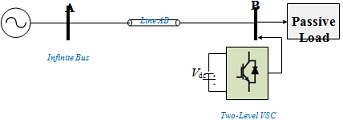Advanced AC and DC Transmission Systems
Coursework 1 -Part A
Case Studies with Computer Aided Simulations
This is an individual-based assessment where you are expected to carry out the tasks with Matlab/Simulink and write a technical report. You would have to keep to the maximum word limit for this part of the coursework (2500 words).
Case study: Control and Operation of HVDC Lines
A: Explain in detail aided with illustrations and schematics as appropriate the use of the following DC fault protection methods (Comment on the efficacy of each method):
(i) Artificial AC Fault protection method.
(ii) Solid state DC circuit breaker
(iii) Hybrid DC circuit breaker
(iv) Full Bridge MMC
B: Using an appropriate Simulink model for a modular multilevel converter (MMC) station connected to an HVDC line, explain (aided with suitable waveforms exported to your report):
(i) The DC fault current profiles (with no MMC protection) in each DC pole upon a pole to pole DC fault occurring at different distances from the MMC station. Comment on the change in AC currents and DC current peaks.
(ii) Compare the DC fault current profiles at 20km distance from the MMC station with and without the ACCB tripping 50ms after DC fault detection.
(iii) The impact of using any of the DC fault protection methods in (a) on the DC fault current profile. Consider the ACCB trips 50ms after DC fault detection.
(Note: you must clarify key parameters used in (i), (ii), and (iii) such as distance from MMC station, DC fault resistance, DC choke inductance, etc).
Coursework -Part B

Fig. 1: The benchmark AC transmission network Table I: Initial Specifications of AC Transmission Network
Bus A is the infinite (slack) bus 1 pu
Reactance between Buses A and B 0.5 pu
X/R ratio 10
Initial active power of passive load at Bus B 0.8 pu
Range of load active power variation at bus B 0.5 - 1.1pu
Base voltage 220kV
Base Power 500MVA
Power frequency 50Hz
Power factor 0.9
Question 1
Based on the above described system and with the aid of the available exercise MATLAB files:
(a) Calculate the impedance of line AB in Ohms.
(b) Calculate Loads B active and reactive powers in MW and MVAR, respectively.
(c) Verify part (b) via simulation.
(b) Use three simulation case studies to evaluate how the variation of Line AB impedance may affect it Bus B voltage profile. Comment on the results.
(e) Use simulation three case studies to estimate the capacitance value that should be added (not shown in Fig.1) to regulate Bus B between 0.9-1.05pu. Comment on the results.
(f) [Theoretical] To regulate the voltage at bus B within the range of 0.9-1.05pu, describe two methods that can perform the task other than the fixed capacitor used in part(e). Your answer must include the following:
Schematic diagrams, academic references and which method you will prefer and why. No Simulations are required.
Question 2 Consider the VSC generic average model benchmark, shown in Fig. 2:

Fig. 2: VSC generic average model installed at Bus B
(a) [Theoretical] Using block diagram, briefly explain the use of Phase Locked Loop (PLL).
(b) Using appropriate simulation, show how to use the PLL to generate d-q frame voltages and currents at bus B.
(c) Using appropriate simulation, Based on the d-q frame used in (b), verify the active and reactive power calculations of load B.
(d) [Theoretical] If a detailed two-level VSC, see Fig. 3, is used show how the active and reactive powers are controlled by generating the two-level VSC IGBT gating signals.
Support your answer with academic references and illustrative diagrams.

Fig. 3: Two-level detailed VSC installed at Bus C
Smart Grids and Sustainable Energy Systems
Coursework: Operation and control of Doubly-Fed Induction Generator Wind Turbine (DFIG-WT)
Wind turbines are playing a major role in renewable power generation in the UK. The electrical generator system is one of the core parts in a wind turbine. Using information gathered from a minimum of 8 different sources/references (e.g. books, journal papers, company websites, etc...), write a report that identifies the operating principles, characteristics and application of the DFIG-WT. Use any appropriate/available software (e.g. MATLAB) wherever applicable within your report. Your report should discuss the following points (aided with solid graphs, plots, tables, and numerical data):
• Introduction to the structure and operation of a generic wind turbine system.
• The major types of electrical generator used in wind turbines and their typical ratings.
• The operational principles of Permanent Magnet Synchronous Generator (PMSG).
• The operational principles of Double-Fed Induction Generator (DFIG).
• Provide comments and concise explanations on the strengths and weaknesses of PMSG and DFIG in terms industrial implementations.
• Operation of the DFIG-WT in super-synchronous and sub-synchronous modes as well as the point of zero slip.
• Fault ride through capability of DFIG-WTs and its operation under AC faults.
The report should be limited to 2500-3000 words. The report should provide evidence of the following:
• Professional presentation and structure of information
• Evidence of background reading and correct use of relevant reference material, sources used should be identified in the manner shown in IEEE journals
• Technical description and critical evaluation of the power electronics and its application
• Relevance and accuracy of arguments
• Relevant conclusions